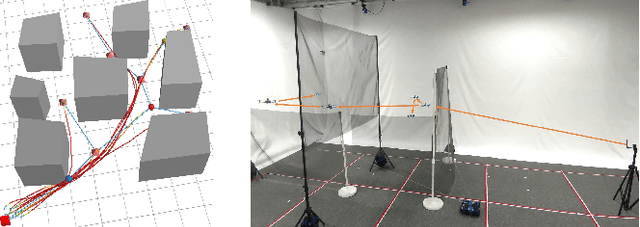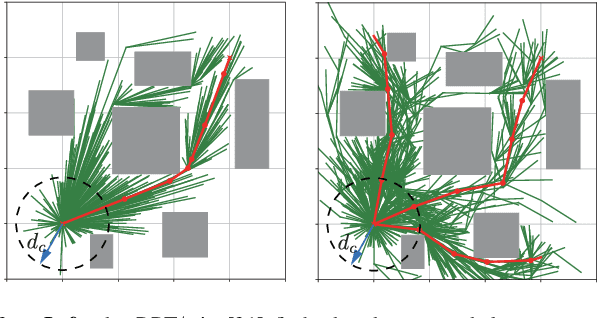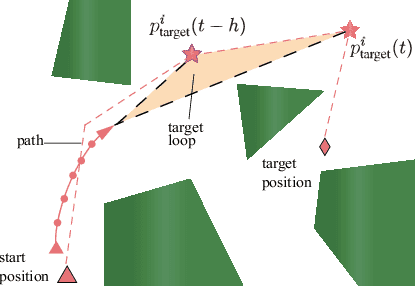Meng Guo
FlyKites: Human-centric Interactive Exploration and Assistance under Limited Communication
Sep 19, 2025Abstract:Fleets of autonomous robots have been deployed for exploration of unknown scenes for features of interest, e.g., subterranean exploration, reconnaissance, search and rescue missions. During exploration, the robots may encounter un-identified targets, blocked passages, interactive objects, temporary failure, or other unexpected events, all of which require consistent human assistance with reliable communication for a time period. This however can be particularly challenging if the communication among the robots is severely restricted to only close-range exchange via ad-hoc networks, especially in extreme environments like caves and underground tunnels. This paper presents a novel human-centric interactive exploration and assistance framework called FlyKites, for multi-robot systems under limited communication. It consists of three interleaved components: (I) the distributed exploration and intermittent communication (called the "spread mode"), where the robots collaboratively explore the environment and exchange local data among the fleet and with the operator; (II) the simultaneous optimization of the relay topology, the operator path, and the assignment of robots to relay roles (called the "relay mode"), such that all requested assistance can be provided with minimum delay; (III) the human-in-the-loop online execution, where the robots switch between different roles and interact with the operator adaptively. Extensive human-in-the-loop simulations and hardware experiments are performed over numerous challenging scenes.
DEXTER-LLM: Dynamic and Explainable Coordination of Multi-Robot Systems in Unknown Environments via Large Language Models
Aug 20, 2025Abstract:Online coordination of multi-robot systems in open and unknown environments faces significant challenges, particularly when semantic features detected during operation dynamically trigger new tasks. Recent large language model (LLMs)-based approaches for scene reasoning and planning primarily focus on one-shot, end-to-end solutions in known environments, lacking both dynamic adaptation capabilities for online operation and explainability in the processes of planning. To address these issues, a novel framework (DEXTER-LLM) for dynamic task planning in unknown environments, integrates four modules: (i) a mission comprehension module that resolves partial ordering of tasks specified by natural languages or linear temporal logic formulas (LTL); (ii) an online subtask generator based on LLMs that improves the accuracy and explainability of task decomposition via multi-stage reasoning; (iii) an optimal subtask assigner and scheduler that allocates subtasks to robots via search-based optimization; and (iv) a dynamic adaptation and human-in-the-loop verification module that implements multi-rate, event-based updates for both subtasks and their assignments, to cope with new features and tasks detected online. The framework effectively combines LLMs' open-world reasoning capabilities with the optimality of model-based assignment methods, simultaneously addressing the critical issue of online adaptability and explainability. Experimental evaluations demonstrate exceptional performances, with 100% success rates across all scenarios, 160 tasks and 480 subtasks completed on average (3 times the baselines), 62% less queries to LLMs during adaptation, and superior plan quality (2 times higher) for compound tasks. Project page at https://tcxm.github.io/DEXTER-LLM/
MoRoCo: Multi-operator-robot Coordination, Interaction and Exploration under Restricted Communication
Aug 11, 2025Abstract:Fleets of autonomous robots are increasingly deployed alongside multiple human operators to explore unknown environments, identify salient features, and perform complex tasks in scenarios such as subterranean exploration, reconnaissance, and search-and-rescue missions. In these contexts, communication is often severely limited to short-range exchanges via ad-hoc networks, posing challenges to coordination. While recent studies have addressed multi-robot exploration under communication constraints, they largely overlook the essential role of human operators and their real-time interaction with robotic teams. Operators may demand timely updates on the exploration progress and robot status, reprioritize or cancel tasks dynamically, or request live video feeds and control access. Conversely, robots may seek human confirmation for anomalous events or require help recovering from motion or planning failures. To enable such bilateral, context-aware interactions under restricted communication, this work proposes MoRoCo, a unified framework for online coordination and exploration in multi-operator, multi-robot systems. MoRoCo enables the team to adaptively switch among three coordination modes: spread mode for parallelized exploration with intermittent data sharing, migrate mode for coordinated relocation, and chain mode for maintaining high-bandwidth connectivity through multi-hop links. These transitions are managed through distributed algorithms via only local communication. Extensive large-scale human-in-the-loop simulations and hardware experiments validate the necessity of incorporating human robot interactions and demonstrate that MoRoCo enables efficient, reliable coordination under limited communication, marking a significant step toward robust human-in-the-loop multi-robot autonomy in challenging environments.
Robust Visual Servoing under Human Supervision for Assembly Tasks
Apr 16, 2025Abstract:We propose a framework enabling mobile manipulators to reliably complete pick-and-place tasks for assembling structures from construction blocks. The picking uses an eye-in-hand visual servoing controller for object tracking with Control Barrier Functions (CBFs) to ensure fiducial markers in the blocks remain visible. An additional robot with an eye-to-hand setup ensures precise placement, critical for structural stability. We integrate human-in-the-loop capabilities for flexibility and fault correction and analyze robustness to camera pose errors, proposing adapted barrier functions to handle them. Lastly, experiments validate the framework on 6-DoF mobile arms.
iHERO: Interactive Human-oriented Exploration and Supervision Under Scarce Communication
May 21, 2024



Abstract:Exploration of unknown scenes before human entry is essential for safety and efficiency in numerous scenarios, e.g., subterranean exploration, reconnaissance, search and rescue missions. Fleets of autonomous robots are particularly suitable for this task, via concurrent exploration, multi-sensory perception and autonomous navigation. Communication however among the robots can be severely restricted to only close-range exchange via ad-hoc networks. Although some recent works have addressed the problem of collaborative exploration under restricted communication, the crucial role of the human operator has been mostly neglected. Indeed, the operator may: (i) require timely update regarding the exploration progress and fleet status; (ii) prioritize certain regions; and (iii) dynamically move within the explored area; To facilitate these requests, this work proposes an interactive human-oriented online coordination framework for collaborative exploration and supervision under scarce communication (iHERO). The robots switch smoothly and optimally among fast exploration, intermittent exchange of map and sensory data, and return to the operator for status update. It is ensured that these requests are fulfilled online interactively with a pre-specified latency. Extensive large-scale human-in-the-loop simulations and hardware experiments are performed over numerous challenging scenes, which signify its performance such as explored area and efficiency, and validate its potential applicability to real-world scenarios.
Collaborative Planar Pushing of Polytopic Objects with Multiple Robots in Complex Scenes
May 13, 2024Abstract:Pushing is a simple yet effective skill for robots to interact with and further change the environment. Related work has been mostly focused on utilizing it as a non-prehensile manipulation primitive for a robotic manipulator. However, it can also be beneficial for low-cost mobile robots that are not equipped with a manipulator. This work tackles the general problem of controlling a team of mobile robots to push collaboratively polytopic objects within complex obstacle-cluttered environments. It incorporates several characteristic challenges for contact-rich tasks such as the hybrid switching among different contact modes and under-actuation due to constrained contact forces. The proposed method is based on hybrid optimization over a sequence of possible modes and the associated pushing forces, where (i) a set of sufficient modes is generated with a multi-directional feasibility estimation, based on quasi-static analyses for general objects and any number of robots; (ii) a hierarchical hybrid search algorithm is designed to iteratively decompose the navigation path via arch segments and select the optimal parameterized mode; and (iii) a nonlinear model predictive controller is proposed to track the desired pushing velocities adaptively online for each robot. The proposed framework is complete under mild assumptions. Its efficiency and effectiveness are validated in high-fidelity simulations and hardware experiments. Robustness to motion and actuation uncertainties is also demonstrated.
Uncertainty-bounded Active Monitoring of Unknown Dynamic Targets in Road-networks with Minimum Fleet
Sep 19, 2023



Abstract:Fleets of unmanned robots can be beneficial for the long-term monitoring of large areas, e.g., to monitor wild flocks, detect intruders, search and rescue. Monitoring numerous dynamic targets in a collaborative and efficient way is a challenging problem that requires online coordination and information fusion. The majority of existing works either assume a passive all-to-all observation model to minimize the summed uncertainties over all targets by all robots, or optimize over the jointed discrete actions while neglecting the dynamic constraints of the robots and unknown behaviors of the targets. This work proposes an online task and motion coordination algorithm that ensures an explicitly-bounded estimation uncertainty for the target states, while minimizing the average number of active robots. The robots have a limited-range perception to actively track a limited number of targets simultaneously, of which their future control decisions are all unknown. It includes: (i) the assignment of monitoring tasks, modeled as a flexible size multiple vehicle routing problem with time windows (m-MVRPTW), given the predicted target trajectories with uncertainty measure in the road-networks; (ii) the nonlinear model predictive control (NMPC) for optimizing the robot trajectories under uncertainty and safety constraints. It is shown that the robots can switch between active and inactive roles dynamically online as required by the unknown monitoring task. The proposed methods are validated via large-scale simulations of up to $100$ robots and targets.
Multi-agent Coordination Under Temporal Logic Tasks and Team-Wise Intermittent Communication
Sep 06, 2023

Abstract:Multi-agent systems outperform single agent in complex collaborative tasks. However, in large-scale scenarios, ensuring timely information exchange during decentralized task execution remains a challenge. This work presents an online decentralized coordination scheme for multi-agent systems under complex local tasks and intermittent communication constraints. Unlike existing strategies that enforce all-time or intermittent connectivity, our approach allows agents to join or leave communication networks at aperiodic intervals, as deemed optimal by their online task execution. This scheme concurrently determines local plans and refines the communication strategy, i.e., where and when to communicate as a team. A decentralized potential game is modeled among agents, for which a Nash equilibrium is generated iteratively through online local search. It guarantees local task completion and intermittent communication constraints. Extensive numerical simulations are conducted against several strong baselines.
Multi-UAV Deployment in Obstacle-Cluttered Environments with LOS Connectivity
Aug 23, 2023



Abstract:A reliable communication network is essential for multiple UAVs operating within obstacle-cluttered environments, where limited communication due to obstructions often occurs. A common solution is to deploy intermediate UAVs to relay information via a multi-hop network, which introduces two challenges: (i) how to design the structure of multi-hop networks; and (ii) how to maintain connectivity during collaborative motion. To this end, this work first proposes an efficient constrained search method based on the minimum-edge RRT$^\star$ algorithm, to find a spanning-tree topology that requires a less number of UAVs for the deployment task. To achieve this deployment, a distributed model predictive control strategy is proposed for the online motion coordination. It explicitly incorporates not only the inter-UAV and UAV-obstacle distance constraints, but also the line-of-sight (LOS) connectivity constraint. These constraints are well-known to be nonlinear and often tackled by various approximations. In contrast, this work provides a theoretical guarantee that all agent trajectories are ensured to be collision-free with a team-wise LOS connectivity at all time. Numerous simulations are performed in 3D valley-like environments, while hardware experiments validate its dynamic adaptation when the deployment position changes online.
Tackling the Curse of Dimensionality in Large-scale Multi-agent LTL Task Planning via Poset Product
Aug 22, 2023



Abstract:Linear Temporal Logic (LTL) formulas have been used to describe complex tasks for multi-agent systems, with both spatial and temporal constraints. However, since the planning complexity grows exponentially with the number of agents and the length of the task formula, existing applications are mostly limited to small artificial cases. To address this issue, a new planning algorithm is proposed for task formulas specified as sc-LTL formulas. It avoids two common bottlenecks in the model-checking-based planning methods, i.e., (i) the direct translation of the complete task formula to the associated B\"uchi automaton; and (ii) the synchronized product between the B\"uchi automaton and the transition models of all agents. In particular, each conjuncted sub-formula is first converted to the associated R-posets as an abstraction of the temporal dependencies among the subtasks. Then, an efficient algorithm is proposed to compute the product of these R-posets, which retains their dependencies and resolves potential conflicts. Furthermore, the proposed approach is applied to dynamic scenes where new tasks are generated online. It is capable of deriving the first valid plan with a polynomial time and memory complexity w.r.t. the system size and the formula length. Our method can plan for task formulas with a length of more than 60 and a system with more than 35 agents, while most existing methods fail at the formula length of 20. The proposed method is validated on large fleets of service robots in both simulation and hardware experiments.
 Add to Chrome
Add to Chrome Add to Firefox
Add to Firefox Add to Edge
Add to Edge